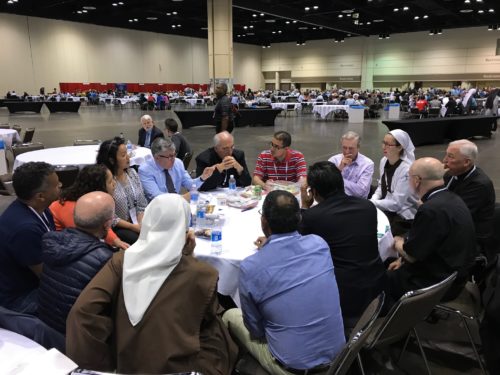My dear brothers and sisters in the Lord,

Recently, I returned from the United States Conference of Catholic Bishops,’ called the “Convocation of Catholic Leaders: The Joy of the Gospel in America.” This was an unprecedented gathering lead by U.S. bishops and key leaders from dioceses, apostolates and Catholic organizations from across the United States. In fact, the meeting was the first time that the USCCB ever called together such a gathering. Over 80 percent of the dioceses attended, with close to 200 bishops also in attendance. Almost 20 members from our Diocese were present, including Auxiliary Bishops Cisneros, Tiedemann, Sansaricq and Massa.
The conference was well-planned. In fact, I was a bit surprised at how well it went with so many people attending. In many ways, the convocation followed the Apostolic Exhortation of our Holy Father, Pope Francis, “The Joy of the Gospel.” The systematic approach to examining the problems followed the “See, Judge and Act” model which was long used in the Christian student’s movement of many generations ago. In fact, the convocation worked better than anyone expected.
The conference focused on those who are at the peripheries of our society, the Church’s vision and sometimes our concerns. More than 40 workshops were available. During the discussion with our own diocesan participants, it became clear to me and to them that we had most of the peripheries right here in Brooklyn and Queens. At every turn, we found another issue that existed here in our diocese that perhaps did not exist in other dioceses. As a large urban diocese with a multitude of problems and with our multi-ethnic and immigration populations, we are truly at the peripheries. In fact, being at the conference recalled to mind the greeting I gave to Pope Francis in Italian when he arrived at Kennedy Airport, “Welcome to the peripheries of New York!”
The methodology employed, as one explained, was the right and the left brain approach to human understanding. The right brain is usually called the emotional side, while the left brain is usually called the more intellectual side. And so we were stimulated in both ways, mostly on the right side with very moving liturgies and devotions that truly brought more than 4,000 people together in celebrating their faith. While at the same time, especially during the major talks, our intellectual understanding of the problems of the Church today were stimulated. We also discussed some of the solutions that are available to us. All of the major addresses were well done and well planned, leaving us all wondering how we can implement some of the suggestions in our own dioceses.
One of the best parts of the conference was our ability as a diocesan delegation to speak together about what we had heard and seen, and how it could be applied here in Brooklyn and Queens. In several hours of conversation, our lay leadership and diocesan staff who were also in attendance were able to define those areas of priority that perhaps we need to address as a diocese. Some of these coincide with goals that I have set for the next several years.
We have yet to roll out these goals and we will combine them with the suggestions of the conference, so that we will project for the next several years diocesan goals that will reach the peripheries of our diocese in Brooklyn and Queens, where many people still suffer, or are ignored, or are beyond our view.
The concluding remarks by our Papal Nuncio, Archbishop Christophe Pierre, truly summed up this wonderful convocation. He began by reminding us of the concern Pope Francis has for the Church Universal and how we, in what can be called a “Right Moment,” a kairos moment, were given a special moment of grace through our participation in the conference. We recognize the challenges before us, especially the increasing secularization of our society. As we recognize that almost 25 percent of Americans identify themselves a “NONES,” meaning that they feel they have “no religion.” This is a phenomenon that includes at least 20 million Catholics, especially those ages 18 to 30. Truly, these people have become part of the peripheries that we are not reaching. It is important also that we recognize the universality of the Church and that our problems are not only local, they are national and also universal. We must reach out to the Church in the rest of the world in order to recognize our responsibilities and fulfill them.
Archbishop Pierre emphasized that the Pontificate of Pope Francis has one key word, the “accompaniment” of those on the pilgrimage of life, no matter where they find themselves – in the center or on the peripheries. The pilgrimage of life is a journey of faith that we must recognize is taken at different paces and in different directions. Yet still, life is a journey that needs accompaniment and understanding.
Finally, the Apostolic Nuncio reminded us that we need to look to Mary, especially under the title of Our Lady of Guadalupe, who appeared at the peripheries of the Mexican society at beginning the New Evangelization in the Americas.
The Convocation of Catholic Leaders was an exercise of putting out into the deep for the Church in the United States. Together we need to identify the peripheries around us and reach out to those who are there. Join me in prayer for our successful implementation of what we learned.
